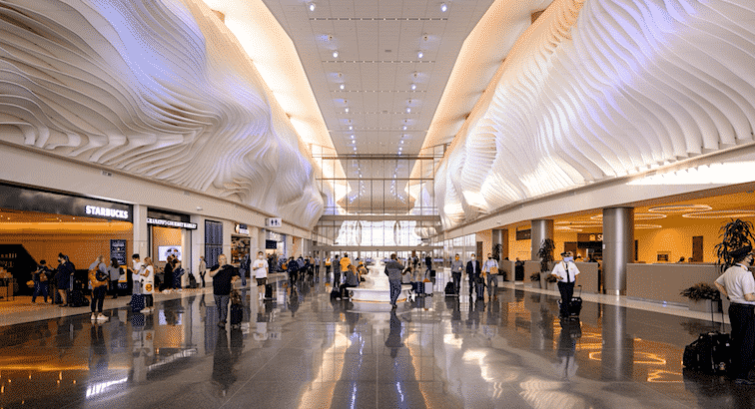By Justin Noah and David DeVoss
No structures better captured the spirit of America than airports. When it opened in 1960, Idlewild’s Pan Am Worldport embodied the Space Age with a circular roof that projected outward like a hovering flying saucer. TWA asked Finnish American architect Ero Saarinen to “capture the spirit of flight” and in 1962 his concrete and glass Trans World Flight Center in New York did exactly that with curvilinear walls and a roof shaped like an eagle in flight.
The polish, glamor and optimism of 1960’s airports soon succumbed to bureaucratic inflexibility, tighter security and the need to funnel more people onto ever larger planes. Airports conceived as centers of romance and imagination became generic depots that could be hosed down and squeegeed at night. Lamented British author Dennis Potter in a 1978 letter to The Sunday Times: “I did not fully understand the dread term ‘terminal illness’ until I saw Heathrow for myself.”
Ironically, the worst disaster in aviation history ushered in a golden age of airports. Because enhanced security following 9/ll required passengers to be at the terminal two hours or more before their flight, airports were forced to provide more than beer, coffee, newspapers and donuts. People with 90 minutes to fill demanded places to read, charge cell phones, check email and enjoy a meal.
Until the coronavirus brought commercial aviation to its knees six months ago, airlines were enjoying unprecedented profits powered by full flights and unfettered fees. Revenues earned prior to February 2020 today are paying for new airports around the world that should be operating at peak efficiency when the travel industry returns to its 2019 level.
One ambitious redevelopment that opened last month is Salt Lake City International Airport. The project literally is a work of art that reflects the dimension, palette and texture of Utah’s dramatic landscape.
The $4.2 billion development will replace three aging terminals with one large consolidated building. It is the creation of HOK architects in San Francisco and 61-year old California artist Gordon Heuther, who previously designed airports in Jacksonville, Sacramento and Ft. Lauderdale.
“What we have in Salt Lake City’s new airport is an uninterrupted, fully immersive art experience from the moment you enter to the moment you board the plane,” Huether says, adding that his goal was to use different materials and aesthetics to give people passing through the 4 million-sq. ft structure an appreciation of Utah’s beauty.
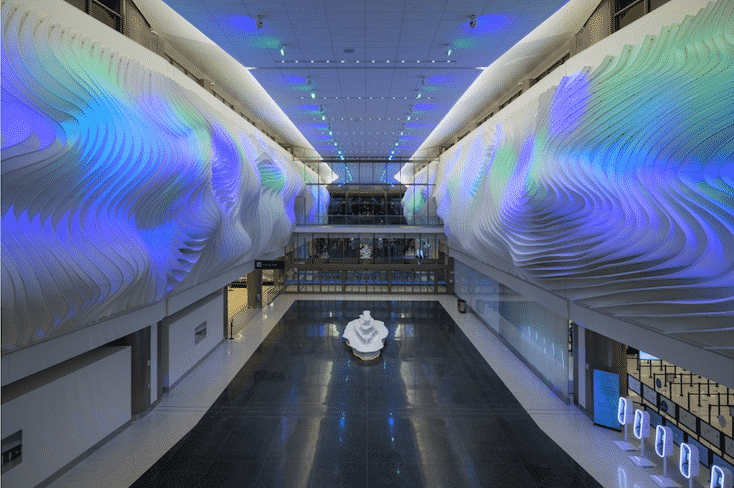
“The Canyon,” a 362-ft. long artistic design, features programmed lighting that simulates the light and shadow that gives life to Utah”s topography.
One of the many extraordinary art features that represent Utah’s landscape is a feature called The Canyon. Using more than two acres of composite fabric and the equivalent of seven miles of aluminum tubing, the design corridor representing the state’s canyon landscape runs longer than a football field. Programmed lighting gives the sculpture a constantly evolving lifelike quality.
Huether describes the new airport as a “cathedral for transportation.” Specially curated art works complement the overall design.
Matt Needham, one of the architects who worked on SLC’s airport, says HOK had to remove “barriers of frustration” before it could create a place of wonder and imagination.
One change was the redesign of runways so that planes arriving early could dock at an alternative gate and avoid waiting on the tarmac. Another ingenious design feature was the placement of large magnets under the floors that would hold the metal stanchions with retractable belts used to direct pedestrian traffic. Eliminating the need for heavy bases allows stanchions to be moved easily and foot traffic quickly redirected.
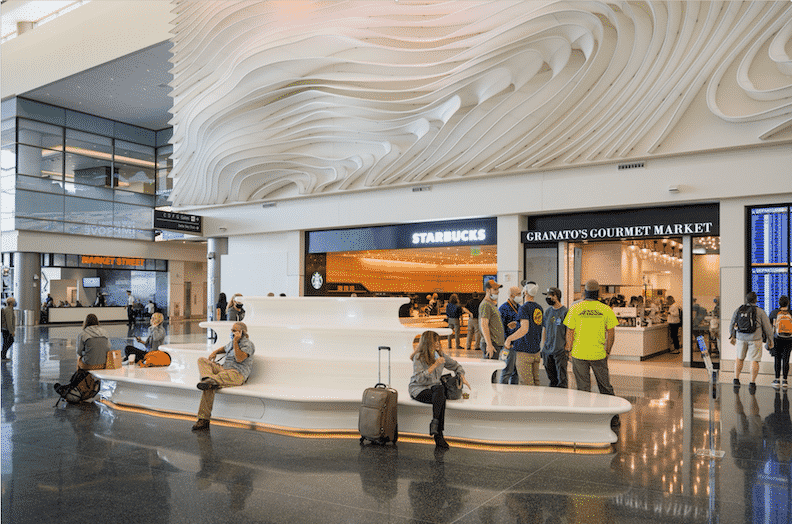
Passengers awaiting flights are welcome to sit on a sculpture that complements the 500 tensile membrane fins decorating the wall.
“From inception our focus was on the traveler’s journey,” explains Needham. “Making employees jobs easier allows travelers to have the best experience.”
At most airports, travelers push plastic bins with their carry-on items up to the security check. Once past the x-ray, they must empty the bin and place it on a stack, where a TSA employee will move everything back to the start of the line. At SLC, delays largely are eliminated by an electronic roller system that loops the bins through the security check with minimum human contact. TSA security checks now operate 30% faster.
Passengers also enjoy improved shopping and food service. At SLC, there are 29 retail stores and 23 different dining options. Bars and cafes signed contracts promising to eliminate the traditional 10-20% premium and charge off airport prices. Despite the lower prices revenue is up because passengers spend more when prices are fair.
Berlin Brandenburg Airport
Europe’s newest airport is the Brandenburg Airport in Berlin (BER). Scheduled to open at the end of October, Brandenburg will have three terminals and two runways on 3,632 acres. Its innovative design allows for an initial annual capacity of 27 million passengers that will increase to 45 million passengers a year.
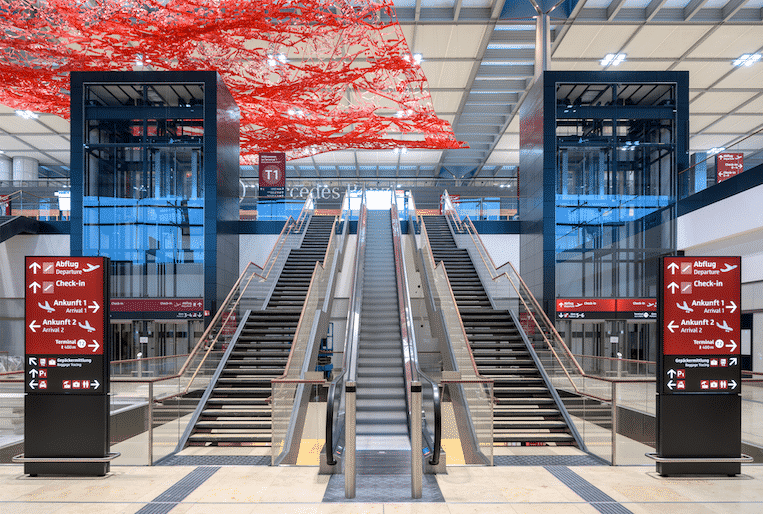
Passengers ascending to the Berlin Brandenburg Airport’s second floor get an up close view of artist Pae White’s floating carpet of red mesh that seems to hover in the air.
The airport incorporates local nature as a main theme. The grand façade features geometrical lines inspired by local pine forests along with other elements that employ natural stone and warm wood tones and natural stone. Like SLC, BER utilizes a functional “one roof concept” that maximizes the open-air space. The visual centerpiece of the check-in hall is a large, seemingly floating, red wave made of metal mesh flutters. Designed by Los Angeles-based artist Pae White, the work might be reminiscent of a flying carpet or membrane between the known and the unknown.
Dining and retail were in mind from the beginning of the design. The facility will provide everything from quick grab-and-go grub to fine restaurant dining. In the 100,000 square foot retail plaza, there will be 39 restaurants and 20 service companies. The Steigenberger Airport Hotel is located directly at the terminal and within walking from the train station. It features 322 rooms as well as a conference center with meeting space for up to 500 people, fine dining and a spa.
Abu Dhabi International Airport
By this time next year, the 7 million-sq. ft. Abu Dhabi International Airport in the United Emirates will be the largest airport in the world. Located a three hour drive down the Persian Gulf coast from Dubai, a neighboring emirate that presently has the world’s fourth busiest airport, Abu Dhabi’s Midfield Terminal will be the most modern aviation facility in the world.
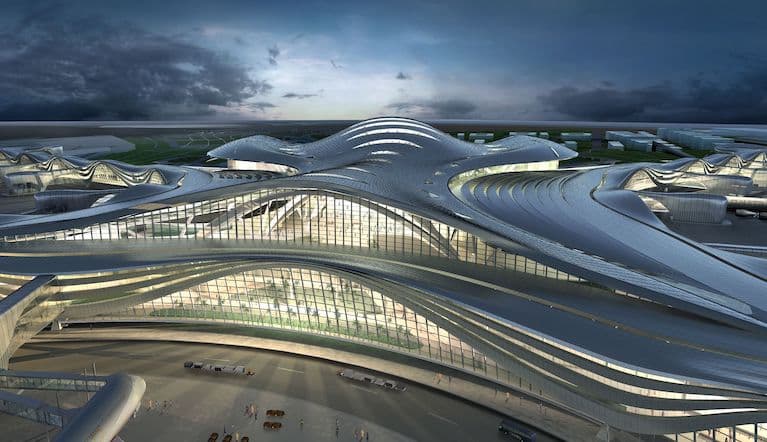
Abu Dhabi’s Midfield Terminal will be finished in 2021
The designers claim despite the sprawling size of the terminal, passengers can expect of a minimum connecting time of just 45 minutes from gate to gate. This is extremely important for the airport because many passengers will use Abu Dhabi as stopover with a connecting flight.
The airport will have 65 aircraft gates that will increase the airport’s capacity by 30 million passengers with plans that can double capacity in the future. The design features the biggest continuous arch in the world and a downward curving roof to let natural light in but protect the terminal from the sun’s rays. The arch is essential to support an open-air space that is 170 feet at the highest point without any poles from floor to ceiling.
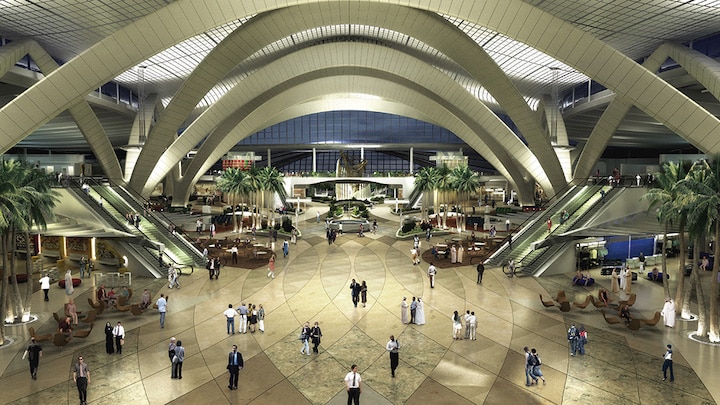
When complete, Abu Dhabi’s Midfield Terminal will be the world’s largest airport.
Abu Dhabi Midfield Terminal is part of a 25-year plan with the goal of making Abu Dhabi a destination rivaling Dubai.![]()
Justin Noah is a senior Television/Film and Entrepreneurship dual major at Syracuse University. East-West News Service editor David DeVoss contributed to this report.


